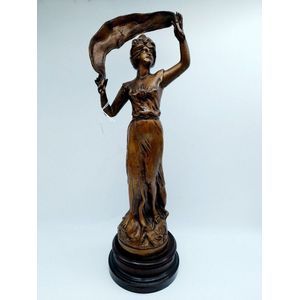French Maiden Figurine "Brise du Matin"
French spelter, figure of a maiden brise du Matin painted on wooden plinth, marked Paris France to reverse
You must be a subscriber, and be logged in to view price and dealer details.
Subscribe Now to view actual auction price for this item
When you subscribe, you have the option of setting the currency in which to display prices to $Au, $US, $NZ or Stg.
This item has been sold, and the description, image and price are for reference purposes only.
- Spelter - Spelter was the name given to an alloy of zinc and brass or copper used in the 19th century for statuary and lighting. It is a brittle bluish-white metal. It was used as a cheap replacement for bronze, but being brittle easily breaks and can't be repaired. When finished it can often be mistaken for bronze, but if discreet a scratch on the base displays shows a greyish colour, the metal is spelter, if a golden colour the metal is most likely bronze.
- Brise Fan - A brise fan consists of flat ribs that become wider from the rivet to the top, and are held in place by a ribbon threaded through slots at the broad end. They do not have a folding leaf. The earliest brise fans came from China and Japan, and were exported to Europe in large quantities from the 17th century onwards. European-made brise fans, an imitation of the delicate Chinese wooden and ivory fans, were composed of thinly-sliced sticks of bone, horn, tortoiseshell, mother-of-pearl, or ivory that were often elaborately carved, gilded, and painted.
This item has been included into following indexes:
